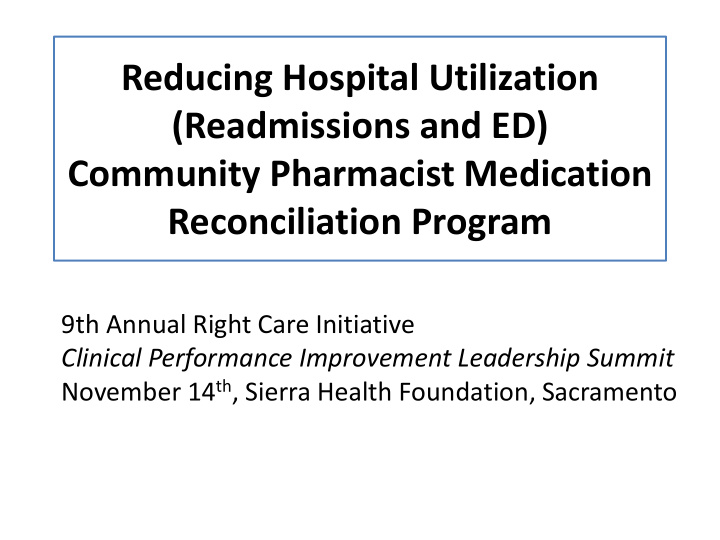



Reducing Hospital Utilization (Readmissions and ED) Community Pharmacist Medication Reconciliation Program 9th Annual Right Care Initiative Clinical Performance Improvement Leadership Summit November 14 th , Sierra Health Foundation, Sacramento
Jeff Mason, MD Rebecca Cupp, RPh Lord Sarino, PharmD Gloria Noell, RN Partners Steve Chen, PharmD Mary Fermazin, MD & Team Jan Hirsch, PhD
Goal • Reduce hospital re-utilization (readmission and ER utilization) by adding community pharmacists to the care team. Study Objective • Conduct and evaluate implementation of a community pharmacy based medication reconciliation (PharmD_MedRec) program for high-risk post-discharge patients. Primary Hypothesis • Proportion of patients with hospital re-utilization (readmission and ED visits) during 30-days post hospital discharge will be lower in the PharmD_MedRec group compared to Usual Care discharge group .
Polling Question #1: Which of the following medications at discharge has not been shown to indicate a high risk of readmission? A. Anticoagulants 25% 25% 25% 25% B. Anticonvulsants C. Insulin D. Oral hypoglycemic agents A B C D
SCREENING at Presbyterian Hospital * Patients not meeting criteria Presbyterian Daily Screening Reports Patients at elevated risk of hospital re-utilization (admission or ED) Inclusion Criteria Exclusion Criteria - Greater than Moderate Risk (LACE tool) - Patients with specific D/C program - Planned Readmission AND/OR - Obstetrics - High Risk medications at discharge - Hospice (anticoagulants, oral anti-platelet, oral - Unwilling to consent hypoglycemic, opioid analgesics, digoxin) AND - Age >18 - Medical & surgical patients - Have phone access - English or Spanish speaking * Presbyterian Intercommunity Proceed to Consent Process Hospital (PIH) – Whittier, CA
CONSENT & RANDOMIZATION at Presbyterian Patients Give Consent Randomization PharmD_MedRec Usual Discharge 240 patients 240 patients Information for Ralphs Pharmacist Information for Study - LACE admission score - LACE admission score - High risk medications – yes/no - High risk medications – yes/no - Discharge order; date, site, diagnoses, - Discharge order; date, site, diagnoses, other pertinent other pertinent - Patient contact information
MTM Session Ralphs + Feedback to Presbyterian Access medication discharge list and other relevant information Presbyterian Medication Reconciliation 72 hrs post D/C notification + Complete weekly f-up x 2 Medication Listing + Other PRN Identified problems for further Nurse Case Manager Presbyterian Case Management &/or Social Worker Confirmed no conflict with Medicare, per region IX CMO. Physician
Polling Question #2: The Community Pharmacist Medication Reconciliation Program described today involves: 25% 25% 25% 25% A. Pharmacists B. Physicians C. Nurse Care Managers D. All of the Above A B C D
Estimated Timeline • Funding approved UHC: 7/28/16 • Contracting among parties: by January 2017 • IRB submission: by December 2016 • Enrollment Begins: March 2017 • Last Patient Out: April 2018 • Reporting: Summer 2018
Two Lessons Learned Before Study Start! • Relationships among partners… it’s complicated. • Counting number of “discrepancies” found during medication reconciliation… it’s tricky
Relationships Among Partners
What is a discrepancy?
Questions for Anyone? Contact: Jan D. Hirsch, BS Pharm, PhD Professor Clinical Pharmacy janhirsch@ucsd.edu
Recommend
More recommend